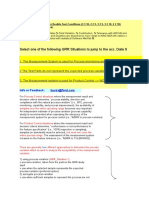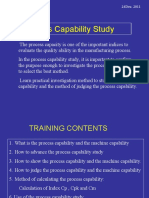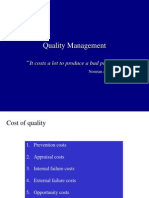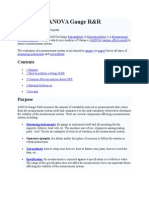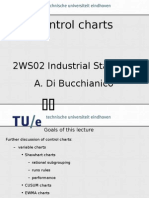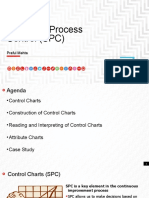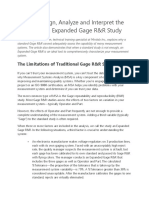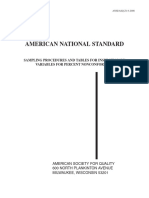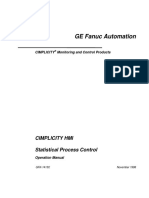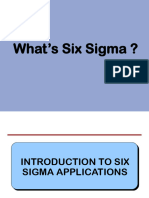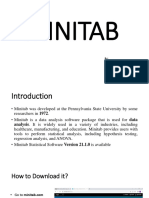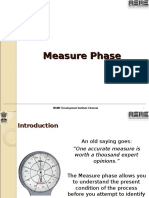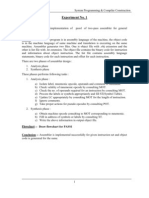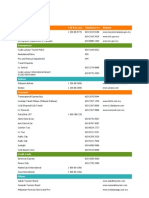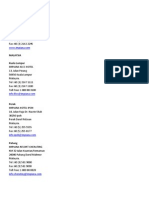L/O/G/O
Statistical Quality Control
In God we trust. ... all others must bring data. --- The Statisticians Creed Presented by: Ashish Jajodia Geet Suri Prahlad Agarwal Sandeep Goyal Sasikiran Battepati Twinkle Jaithalia
�CONTENTS
Introduction Quality control in Production System Control Charts Quality Control in Services Conclusion
Contents 1
�Introduction
Statistical quality control (SQC) is a method of visually monitoring manufacturing processes. With the use of control charts and collecting few but frequent samples, this method can effectively detect changes in the process that may affect its quality. Under the assumption that a manufactured product has variation and this variation is affected by several process parameters, when SQC is applied to "control" each parameter the final result trend to be a more controlled product. SQC can be very cost efficient, as it usually requires collection and charting data already available, while "product control" requires accepting, rejecting, reworking and scrapping products that already went through the whole process.
�QC Throughout Production Systems
Inputs Raw Materials, Parts, and Supplies Conversion Production Processes Outputs Products and Services
Control Charts and Acceptance Tests
Control Charts
Control Charts and Acceptance Tests
Quality of Inputs
Quality of Partially Completed Products
Quality of Outputs
�Control Charts
Primary purpose of control charts is to indicate at a glance when production processes might have changed sufficiently to affect product quality. If the indication is that product quality has deteriorated, or is likely to, then corrective measure is taken. If the indication is that product quality is better than expected, then it is important to find out why so that it can be maintained. Use of control charts is often referred to as statistical process control (SPC).
�Types of Control Chart
Variables Control Charts The quality characteristics are variables and numerical values can be obtained for each Examples: average length, average diameter, average tensile strength, average resistance, average service time. Attributes Control Charts The quality characteristics are the proportion of nonconforming items, the number of nonconformities in a unit, and the number of demerits per unit.
�Control Charts for Variables
Inspection of the units in the sample is performed on a variable basis. The information provided from inspecting a sample of size n is: Sample mean, x, or the sum of measurement of each unit in the sample divided by n Range, R, of measurements within the sample, or the highest measurement in the sample minus the lowest measurement in the sample
�Control Charts for Variables
In this case two separate control charts are used to monitor two different aspects of the processs output: Central tendency Variability Central tendency of the output is monitored using the xchart. Variability of the output is monitored using the R-chart.
�x-Chart
= The central line is x, the sum of a number of sample means collected while the process was considered to be in control divided by the number of samples.
The 3W lower control limit is = - AR x
= The 3W upper control limit is x + AR
Factor A is based on sample size.
�R-Chart
The central line is R, the sum of a number of sample ranges collected while the process was considered to be in control divided by the number of samples. The 3W lower control limit is D1R. The 3W upper control limit is D2R. Factors D1and D2 are based on sample size.
�3W Control Chart Factors for Variables
Sample Size n 2 3 4 5 10 15 20 25 Over 25 Control Limit Factor for Sample Mean A 1.880 1.023 0.729 0.577 0.308 0.223 0.180 0.153 Control Limit Factor for Sample Range D1 0 0 0 0 0.223 0.348 0.414 0.459 0.45+.001 D2 3.267 2.575 2.282 2.116 1.777 1.652 1.586 1.541 1.55-.0015n
�Example: Variable Control Chart
Harry Coates wants to construct x and R charts at the bag-filling operation for Meow Chow cat food. He has determined that when the filling operation is functioning correctly, bags of cat food average 50.01 pounds and regularly-taken 5-bag samples have an average range of .322 pounds.
�Example: Variable Control Chart
Sample Mean Chart x = 50.01, R = .322, n = 5 UCL = x + AR = 50.01 + .577(.322) = 50.196 LCL = x - AR = 50.01 - .577(.322) = 49.824
�Example: Variable Control Chart
x Chart or Meow Chow
50.3 50.2 ample Mean 50. 50.0 49.9 49.8 49.7 0 5 ample 0 mber 5 20
LCL UCL
�Quality Control in Services
In all services there is a continuing need to monitor quality
Control charts are used extensively in services to monitor and control their quality levels With automation, inspection and testing can be so inexpensive and quick that companies may be able to increase sample sizes and the frequency of samples, thus attaining more precision in both control charts and acceptance plans.
�Conclusion
Quality cannot be inspected into products. Processes must be operated to achieve quality conformance; quality control is used to achieve this. Statistical control charts are used extensively to provide feedback to everyone about quality performance.
�Conclusion
Where 100% inspection and testing are impractical, uneconomical, or impossible, acceptance plans may be used to determine if lots of products are likely to meet customer expectations. The trend is toward 100% inspection and testing; automated inspection and testing has made such an approach effective and economical.
�L/O/G/O
Thank You!




